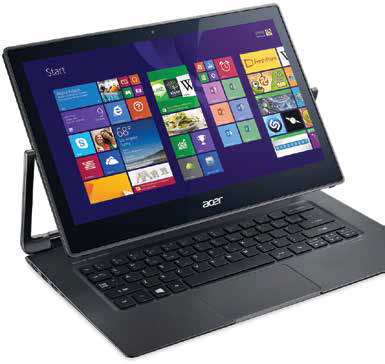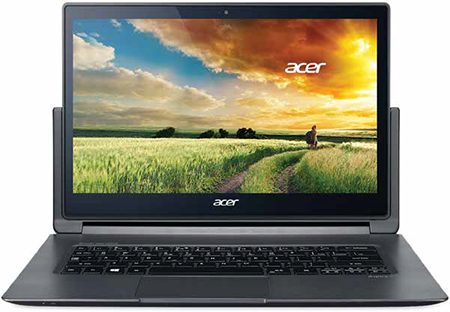BYOx Review: Acer Aspire R 13 Series

MODEL TESTED: ACER R7-371T-57SN
BYOD is old news. The trend is BYOx, and it’s here to stay. With mobile devices (e.g., smartphones, tablets, laptops) and IoT (e.g., Apple Watches) becoming more common enterprise and learning tools, I’m interested in how the panoply of products can actually work together in commercial markets. With the Los Angeles United School District epic iPad deployment fiasco still making headlines this month, I’m also interested in how easily these mobile devices can be managed.
I spent the month of April testing the Acer Aspire R 13 Series, and I am convinced that cord cutting has never been easier. The R 13 is best of two worlds—portability and functionality. In one product, you get a fast laptop with touch control, a slick AV presentation device with Corning Gorilla Glass 3, a streaming media hub, and a tablet. The R 13’s versatility in no way limits its functionality. I’m hard-pressed to find a WQHD product that beats it feature for feature. This underscores the point that sometimes additional devices are not the answer (especially in the TSA line at JFK Airport). If you can streamline the number of devices you own and increase your functionality, it’s a winwin. Media hubs used to cost thousands of dollars; the R 13 provides similar functionality at a fraction of the cost, without limitations or omitted features.
SET-UP
It took me a total of three minutes to get the Acer R 13 Series out of its box and connected to our Wi-Fi network. I’m using a wireless HDMI dongle for connectivity to a short-throw InFocus 1080p projector, and a 5.1 receiver/speaker setup. Once the HDMI was plugged in, it was good to go; it instantly worked and recognized the projector by its model name.

USE CASE
The Acer R 13 Series will function well as a file storage and streaming media hub for a home theater, BYOD space, classroom, huddle space, or conference room. I’m using the R 13 as central brain of my BYOD media testing lab and studio space. Its 13.3-inch screen, touch functionality, and plug-and-play compatibility with networked projectors lend itself to any environment where collaboration is required. It can also be a tabletop display.
A daily selection of features, industry news, and analysis for tech managers. Sign up below.
Of course, this unit can not turn on and off AV end-points, e.g., Lutron dimmers, networked projectors, motorized screens, etc, but if you used it in conjunction with a control system (AMX, Crestron, Control4, Extron, etc), or a Logitech Harmony type of Bluetooth/IR/RF/WiFi transmitter, you will be good to go. The way it is loaded lends itself to any touch system environment.

CONTROL
I control it easily via my iPhone app. I downloaded Remote Mouse app (free for iOS) that lets you connect to the source over the network to allow for remote mouse and keyboard input. Of course, there’s an extended pro version of Remote Mouse ($3.99), as well as a dozen other remote control apps of this ilk that I have used, but the free version works well for the purposes of this BYOD test. I’ve customized the home screen of the R 13 with tiles that shortcut to my dashboard and accounts for Acorn, Netflix, iTunes, Pandora, and PBS (British mystery fans unite). It’s easy to add a folder to the “Start” menu to play content over the network. I never thought I’d say this, but Windows 8.1 makes sense as a media hub interface because of the tiles. You can scroll the tiles, rearrange them, and customize them.
PROCESSING, RAID, MEMORY
The models offer Intel Core i5 or i7 processors, up to 512GB solid state drives with RAID-0 support, and up to 8GB of memory.
CONNECTIVITY & PORTS
It has all the ports I need—HDMI, USB 2.0 and USB 3.0. It was easy to connect to the InfoFocus DLP projector via wireless HDMI dongle (Atlona LinkCast), but the proximity of the USB port and HDMI port is tight, especially since this specific dongle needs USB power to function. It barely fit into both ports and left one USB port out of commission. There was no lag or discernible latency from the Acer source device to the projector, even in full HD viewing mode.

DESIGN AND FORM FACTOR
The form-factor is one of the biggest selling points about the R 13. It has six different viewing modes, and it rotates any way you want. The ports are on the keyboard part of the device rather than the screen, which helps keep it streamlined. Its Ezel Aero Hinge features two separate hinge mechanisms for seamless transition between the myriad user modes. It can operate as a traditional laptop, a tablet, or a presentation machine. Use it flat like a tablet or set it horizontally in a landscape display mode. It has a handy fold-and-flip design which makes it more flexible and valuable than a detachable chassis. When I use iPads with add-on keyboards, I lose time wondering where I put the keyboard. It also comes with a stylus for pen input (called the Acer Active Pen). The Active pen uses Acer Hover Access technology to activate pop-up and tap-on menus. It’s nice to have the pen, touch, or trackpad for different applications; it is easy to switch back and forth among all of the modes. The mousepad is highly sensitive and can be adjusted to the user’s liking.
SIX VIEWING MODES
- Notebook mode is for good keyboard action and productivity.
- Ezel mode brings the display close for convenient reading and web browsing.
- Stand mode works well for flow charts, drawing, etc.
- Pad mode is for use like a tablet for web browsing.
- Tent mode is the best option when space is limited, such as an airplane.
- Display mode is the standard mode for watching videos and multi-player games.
PORTABILITY
The Acer R 13 is what the Surface tries to be, but it is actually much better because it is a fully functional computational device. While the Surface is a tablet masquerading as a laptop, the R 13 is a solid computer that can function as a portable tablet. Super thin, this product is one inch (17.95mm) thick and 1.5kg light. It would be ideal for displaying presentations on the go, in conference rooms, in educational environments, and in the home. It is comparable in thinness and lighter than the MacBook Air, and its multiple viewing modes make it stand apart. It has far more memory and features than most entry-level tablets.
SCREEN QUALITY
Excellent. The 13.3-inch WQHD screen offers a display resolution of 2560×1440 pixels in a 16:9 aspect ratio. It has four times as many pixels as the 720p HDTV video standard. The Corning Gorilla Glass 3 is durable, and it offers crisp resolution, brightness, and high-contrast. The touchscreen works well—very precise and touch-sensitive. All models in this series feature direct-bonding for a brighter display.
AUDIO & VOLUME CONTROL
The Dolby Digital Plus Home Theater audio quality is great. When I tested it with a sound bar and a more extensive set up, it worked very well. Because of the remote iPhone app I’ve chosen, audio control is a bit cumbersome. When using the R 13 with the Logitech Harmony, audio and volume control is seamless.
MIC INPUTS & BYOD AUDIO
This laptop has dual-array microphones. Acer Purified Voice technology tracks the voice of the speaker as he or she moves around the room. The Aspire R 13 is “Skype-certified”.
PRICE-POINT: $999.99
This is a good price-point because it is like the Swiss Army Knife of contemporary mobile computers. The touch input makes it flexible and it works in a variety of locations. It is especially good for people who like the “idea” of a portable tablet but need a solid, mobile work station (word processing, spreadsheets, collaboration software for remote office, etc.) You can either buy a laptop and a tablet, or you could just buy the R 13; I’d recommend just buying this. From an avowed, Mac user, that is saying a lot.
CONS / CONCERNS
• This model does not have a back-facing camera, but you can use the integrated front-facing camera for distance learning, Skype, remote meetings, etc.
• Though the R 13 synced with my network instantly, it didn’t change my time zone automatically, which is more of a Windows issue than an Acer problem.
• Proximity of the USB and HDMI—the ports are close together, so when both HDMI and USB are connected, it’s tight, but totally workable. I hooked both up just fine (the LinkCast dongle in the HDMI is a bit wide).
THE LAST WORD
With such a small form-factor and relatively good price point, this product packs a punch. The product gets high marks for the flexibility of the screen angling and smart dual-torque hinge design. It ticks every box for a BYOD environment without any major shortcomings. For AppleTV loyalists to managers who want to upgrade from Chromebooks to cord-cutters who enjoy media via the Web rather than Cable, this is a solid option.
Margot Douaihy is the Editorial Director of NewBay Media’s AV Technology, Tech Manager Today, and EDUwire.
INFO
ACER
http://us.acer.com/ac/en/US/content/series/aspirer13
Aspire R13 Key Specs:
• Windows 8.1
• Intel Core i5-4210U 1.70 GHz
• 13.3-inch HD (1920 x 1080) 16:9 IPS
• Intel HD Graphics 4400 with Shared Memory
• 8 GB, LPDDR3
• 256 GB SSD
Margot Douaihy, Ph.D., is a lecturer at Franklin Pierce University.

